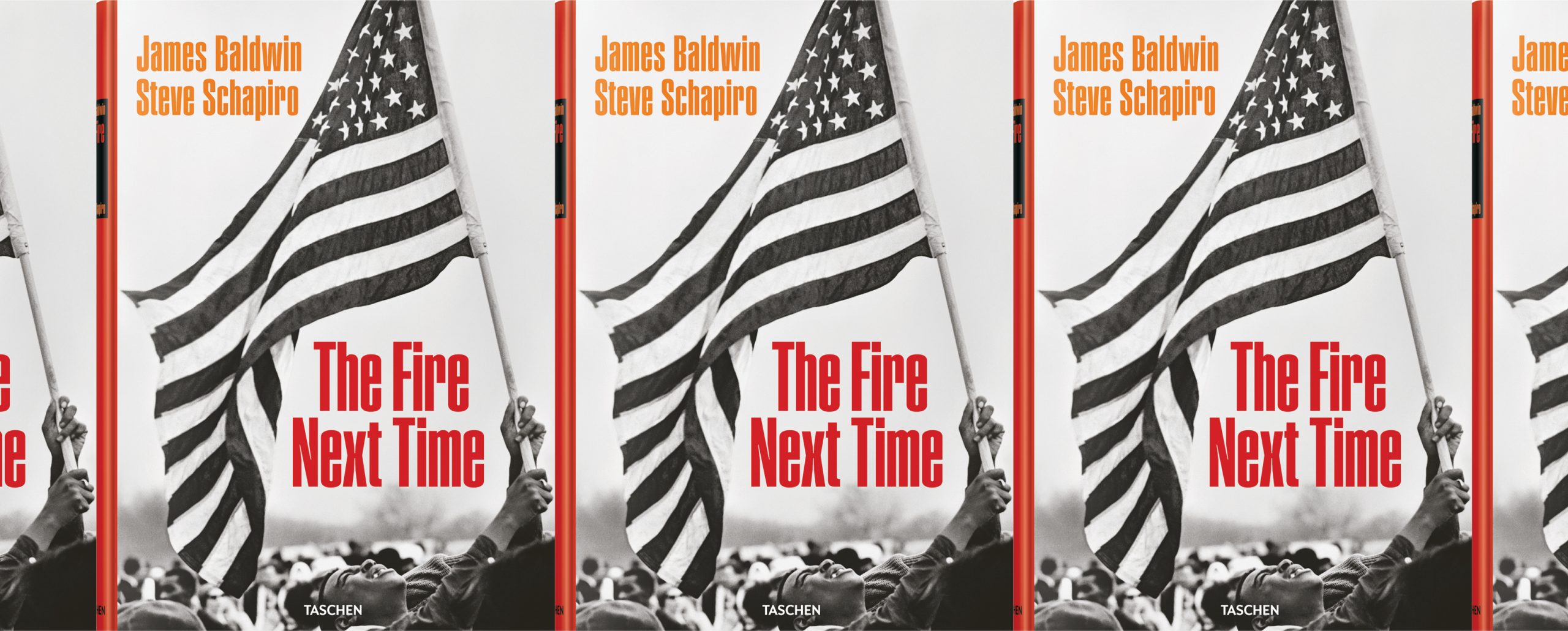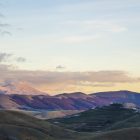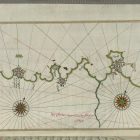Picturing The Fire Next Time

Published in 1963, The Fire Next Time brings together two essays by James Baldwin. “Letter from a Region in My Mind” originally appeared in the New Yorker in November 1962 and serves as the main text of the book; “My Dungeon Shook,” a letter Baldwin wrote to his nephew, first appeared in The Progressive in the same year. The book’s title references a popular spiritual: “God gave Noah the Rainbow sign / No more water but fire next time!” Baldwin ends “Letter from a Region in My Mind” with this biblical reference and warns that its prophecy is upon us if the racial segregation and bigotry of the United States does not change.
When the photographer Steve Schapiro read “Letter from a Region in My Mind” in the New Yorker, he immediately called his editor at Life magazine to ask if he could create a photo essay about its author. Baldwin returned to the United States from France a month later, and Schapiro started traveling with him, first in Harlem and then on a four-week speaking tour in the Deep South. Schapiro’s photographs participate in the awakening that Baldwin calls for at the end of his essay: “to end the racial nightmare, and achieve our country, and change the history of the world.” The 1963 edition of The Fire Next Time did not include any of Schapiro’s photographs from their time together, but a new edition recently published by Taschen weaves Baldwin’s words and Schapiro’s images into a poignant record of their month-long Southern tour and the broader Civil Rights Movement. Schapiro’s photographs, however, do not illustrate Baldwin’s text—instead, the two voices undertake similar strategies, revealing systemic racism and its hypocrisy through the telling of deeply personal, narrative moments.
In “Letter from a Region in My Mind,” Baldwin recalls the entrancing pathos of the songs and rituals of the Church that he discovered when he was fourteen. “I have never seen anything to equal the fire and excitement that sometimes, without warning, fill a church,” he writes. But he also tells of his eventual disillusionment as a young preacher, “the slow crumbling of my faith, the pulverization of my fortress.” He then describes his encounter with the Nation of Islam Movement and the Honorable Elijah Muhammad, when he reluctantly accepts an invitation to dine with him in Chicago. Baldwin had no interest in joining their movement. But he explains the sway of the Nation of Islam after Black American soldiers had been treated as subhuman while fighting next to white American soldiers in World War II and the Korean War. And the persistent threat of nuclear annihilation is, as Baldwin explains in his distinctively sharp tone, “the best that God (the white God) can do. If that is so, then it is time to replace Him.” This disillusionment with a Christian God created a void that the Nation of Islam sought to fill.
Baldwin recounts his experience with the Nation of Islam with the same skepticism as he does the Christian Church. For Baldwin, Christianity cannot be severed from the power and oppressive history of white America. And the Nation of Islam provides a myth of power for a desperate Black America. Ultimately Baldwin declares the urgent need to transcend the segregated tensions of religion. “We, the black and white,” Baldwin wrote, “deeply need each other here if we are really to become a nation.”
The two essays of The Fire Next Time reveal two sides of Baldwin: public and private, righteous rage and gentle compassion. The suspicion and antagonism of “Letter from a Region in My Mind” contrasts with “My Dungeon Shook,” Baldwin’s letter to his nephew, his namesake, James. Baldwin explains the circumstances of his nephew’s life and what it means to be born a Black boy in that historical moment. Yet he hears “the chorus of the innocents screaming, ‘No! This is not true! How bitter you are!’—but I am writing this letter to you, to try to tell you something about how to handle them, for most of them do not yet really know that you exist.” Eventually Baldwin phrases his point more plainly: “You were born where you were born and faced the future that you faced because you were black and for no other reason.” Baldwin is preparing his nephew for his future. Again, he quotes an old spiritual: “The very time I thought I was lost, My dungeon shook and my chains fell off.”
Schapiro photographed Baldwin and James outside the Lewis H. Michaux’s African National Memorial Bookstore in Harlem in January of 1963. They stand near the door as the younger James is taking some teasing from his uncle. Baldwin raises his hand to his nephew’s face, possibly pinching his cheek or tugging his ear, an intimate moment of love in front of a hallowed store. Painted portraits of African leaders appear above the store window, which is filled with records and photographs. Directly behind Baldwin, a vertical sign reads “History of the Negro Retold in Pictures.” The phrase seems to refer as much to Schapiro’s photographs as to the bookstore.
Neither Baldwin nor Schapiro were at home in the South. Upon arriving in Oxford, Mississippi, Schapiro, who was a Jewish New Yorker, was immediately taken to a barbershop by a local photographer who sensed the danger of walking around town with obvious outsiders. By 1962, Baldwin was spending most of his time in Paris, and his worldliness permeated Schapiro’s photographs. In one image, Baldwin stands outside the entrance of a diner in Durham, North Carolina. Dressed in a sophisticated suede coat with wool lining, a dark suit, and assertive glasses, he holds a piece of paper in his hands and looks across the street. Fully self-possessed, he turns away from the sign that announces “Colored Entrance Only” above his head. Schapiro’s narrative is most poignantly told through the contrast between Baldwin and the waiter inside, dressed in an apron and paper hat. The white man presses down on the window’s vinyl blinds and peers suspiciously at the photographer. Schapiro compares models of masculinity here. One moves with confidence in the face of his own social segregation, the other cowers in the shadows.
In another photograph, Baldwin stands in the middle of a wooded field on the outskirts of New Orleans, watching a group of Black boys and girls play next to a dilapidated outhouse and ragged clothes hung on a line. The distance between them is profound. The children are bundled up but dressed in rags and making toys out of whatever they can find. Baldwin wears the same suede coat with wool interior, dark suit, and assertive glasses as in front of the diner in Durham. As the children smile and run around in a circle at play, he looks at them in heavy contemplation, clearly more aware of the reasons for the circumstance of their childhood and the bleakness of their future than they are.
Schapiro’s photographs show us the vast richness of Baldwin’s humanity and the difference between the writer’s public and private versions of himself. The public face of Baldwin we see in sophisticated dress and serious expression contrasts with the images of him at home with his family, laughing with his sister at her home in Harlem. In one photograph, Baldwin dances the hitchhike with a member of CORE, the Congress of Racial Equality that participated in Freedom Rides with other civil rights groups. With his arms out, knees bent, and head cocked to the side, Baldwin appears relaxed and jovial in ways he never does in Schapiro’s photographs in public space.
In The Fire Next Time, Baldwin makes clear his disdain for the white American culture that has allowed for centuries of oppression and greed to pass without comment. Like an ethnographer, he keeps his distance from this culture while at the same time conveying his astute observations of its motivations and systems of power, gathered from living under its oppression his entire life. “The American Negro has the great advantage of having never believed that collection of myths to which white America clings,” Baldwin writes.
Both Baldwin and Schapiro inhabit the role of the watcher. They observe in a way that makes clear they notice something that those they observe do not. Schapiro matches Baldwin’s keen observations of white American rituals. Schapiro photographed a group of men gathered on the side of the road in Philadelphia, Mississippi. The man in the center rests one foot on a guardrail; others are barefoot. They all seem to be sharing a joke. Some raise their arms and shoulders, as if Schapiro’s camera caught them in a moment of convulsive laughter. Schapiro took the photograph while an investigation to recover the car and bodies of three civil rights workers was underway. James Chaney, Michael Schwerner, and Andrew Goodman were murdered by the Ku Klux Klan. The charred remains of Schwerner’s car were dragged from a swamp like the one just visible beyond the guardrail in Schapiro’s photograph. Viewed in the context of Schapiro’s other photographs of the investigation—and beside Baldwin’s essays—the evil of the men becomes unbearably palpable, as they laugh at the crime, barefooted and buzz-cut, at the side of the road.
When he read Baldwin’s essay, Schapiro had already established himself as one of the most compelling practitioners of a documentary style of photography that married humanitarian purpose with a distanced perspective. In the tradition of the documentary photographers Roy DeCarava and Robert Frank, Schapiro saw himself as an observer. Finding injustice to photograph wasn’t difficult, but Schapiro condensed the pressure and energy of the Civil Rights Movement into a single frame. Some of his best photographs contain such a brilliant pairing of text and visual scene that viewers might think they were staged. In one image, Baldwin stands outside a storefront window painted with the words “Muhammad’s Mosque of Islam.” Baldwin turns away from the sign, pausing to write in a small notebook. The image subtly references Baldwin’s narrative account of dining with Elijah Muhammad in “Letter from a Region in My Mind.” The composition reinforces the writer’s defiant suspicion of religion. Schapiro does not directly illustrate the narratives—the scenes of Christian salvation, the impassioned speeches on the street corners of Harlem—through which Baldwin critiques America in the early 1960s; instead, his photographs provide a visual complement to the writer’s sharp and cynical tone.
After his time with Baldwin, Schapiro continued photographing the Civil Rights Movement, thanks in large part to the connections that Baldwin provided for him. He photographed Martin Luther King, Jr., Rosa Parks, and John Lewis as they marched and protested throughout the South. He spent a week with student volunteers in the summer of 1964, who had traveled to Oxford, Ohio to prepare to register African American voters in Mississippi under the relentless threat of bombings, lynchings, and shootings. Both Baldwin and Schapiro grounded their work in observations of the world around them, yet each moved well beyond passive looking. After seeing what they saw, how can we possibly turn away?
About Author
Pepper Stetler is Associate Professor of Art History and Associate Director of the Humanities Center at Miami University in Oxford, Ohio. In addition to writing and researching on the history of photography, she is currently writing a history of the IQ test.



